Currently, the contracted bandwidth of most home broadband users exceeds 100M. Although the contracted bandwidth of users is not low, their experience of internet speed is average. Due to the fact that most of the business of home broadband users is accessed through WiFi, the speed of indoor WiFi has become an important factor affecting the user experience of home broadband.
What is the current situation of indoor WiFi network speed?
Yingda tested the indoor WiFi network speed of 39 home wide users and investigated their subjective feelings about the network speed.
Among the 39 users, 16 have a contracted bandwidth of 100M, which is the highest proportion; But users with a capacity of 200M or above still make up the majority. There is only one gigabit user.
| Contracted bandwidth(M) | User quantity (pc) | Ratio(%) |
| 100 | 16 | 41.0% |
| 200 | 4 | 10.3% |
| 300 | 13 | 33.3% |
| 500 | 6 | 15.4% |
Table 1. User type of bandwidth
Indoor speed measurement point
Users often have multiple internet access locations at home, such as living rooms, bedrooms, study rooms, toilets, etc. Therefore, we set up multiple testing points inside the house to test the WiFi network speed at different locations inside the house.
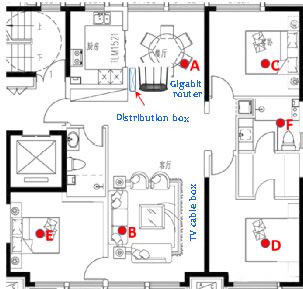
The test points A, B, C, D, E, and F in the figure respectively represent the distance between the speed measurement point and the WiFi router.
A、 No obstruction, distance not exceeding 2 meters, the point with the highest internet speed;
B、 No obstruction, distance exceeding 2 meters;
C、 Separated by one wall, the signal can reach through reflection or diffraction
D、 Separated by one wall, the signal is difficult to reach through reflection or diffraction
E、 Separated by two walls, the signal can reach through reflection or diffraction
F、 The point with severe obstruction and the lowest internet speed.
The relationship between the highest WiFi speed and the contracted bandwidth
Due to the fact that many users are using old optical modem or single frequency WiFi routers, many of them do not support WiFi access above 100MB. Therefore, there is a significant gap between the maximum WiFi speed (test speed at point A) and the contracted bandwidth for many users. Even 15.4% of users have a maximum WiFi speed that is less than 20% of the contracted bandwidth (the vertical axis in the figure shows the ratio of the maximum WiFi speed to the contracted bandwidth).

In order to improve users’ speed measurement experience, operators often limit the downstream speed of home broadband to 120% of the contracted bandwidth, resulting in the phenomenon of the highest WiFi speed exceeding the contracted bandwidth. Even so, only about 41% of users have achieved a maximum WiFi speed of 80% of their contracted bandwidth.
The test point with the lowest WiFi network speed
The internet speed tested at point F, which has the worst wifi signal in the home, is also the lowest. At these test points, more than 20% (8) of users have internet speeds below 10M, and even 3 users have internet speeds below 2M. From the figure below, it can be seen that the minimum internet speed (vertical axis in the figure) is not related to the contracted bandwidth.
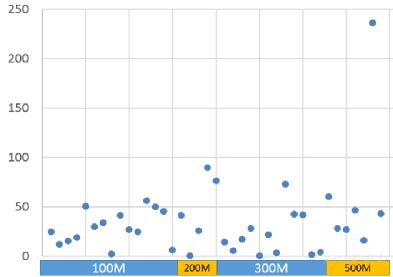
There is also no clear linear relationship between the minimum wifi speed and the maximum wifi speed (horizontal axis in the figure below).
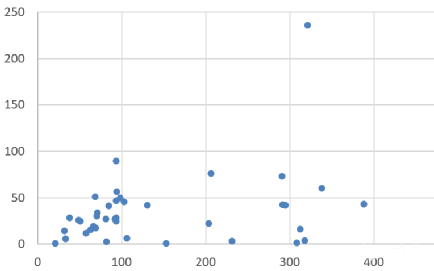
For users with a minimum internet speed below 10M, the signal between the WiFi router and point F is blocked by multiple walls, and the signal is difficult to reach through reflection or diffraction.
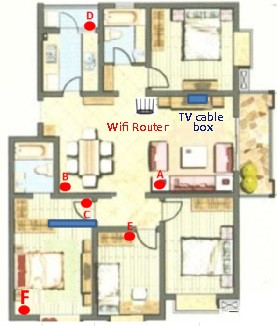
For users with a minimum internet speed above 50M, the signal between the WiFi router and point F is less blocked by walls. Even if blocked, the signal can still reach through reflection or diffraction.
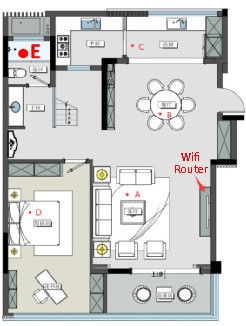
The vast majority of users at point F are located in the bathroom and second bedroom, perhaps due to the fact that they do not spend much time surfing the internet in these locations. Therefore, although the internet speed at point F is generally poor, not a single user out of 39 is dissatisfied with the overall wifi speed.
Network speed of daily online branches
The points where users access the internet on a daily basis are usually not point A, which is very close to the WiFi router, nor point F, which has the worst WiFi coverage, but points B, C, and D. The average network speed of users B, C, and D with different contracted bandwidths is shown in the following figure.
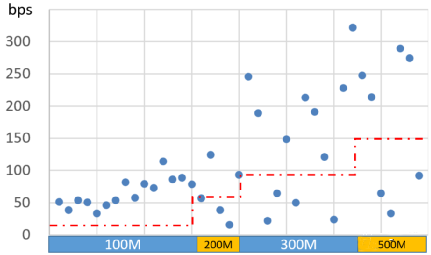
The user’s internet experience is usually related to their expected internet speed, which can be reflected by the ratio of internet speed to contracted bandwidth. The users below the red dashed line in the above picture have an average internet speed of less than 30% of the contracted bandwidth, and their experience can be imagined. And the contracted bandwidth of these users is all 200M or above. The reason for their low network speed on the daily network is not due to insufficient contracted bandwidth, nor is it related to the coverage of indoor WiFi. The main reason is due to the poor performance of the users’ optical modem or WiFi router.
There is a clear linear relationship between the internet speed of the user’s daily internet access point and the highest wifi internet speed (point A’s internet speed). The higher the internet speed at point A (horizontal axis), the higher the internet speed at the user’s daily internet access point (vertical axis).
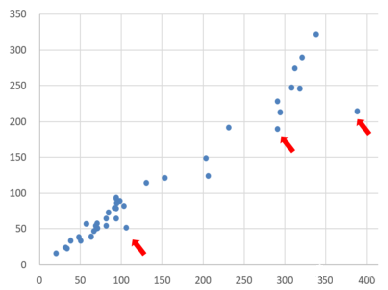
But there are also very few exceptions for users, as indicated by the arrow in the picture, mainly due to the unfavorable location of the WiFi router for indoor coverage.
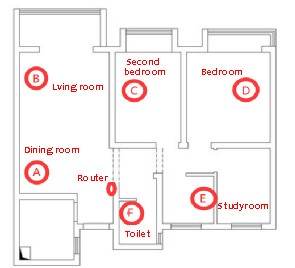
Conclusion
Through testing and analyzing the indoor WiFi network speed of 39 home wide users, we can see that although many users have upgraded their contracted bandwidth to 200M or above, there is generally a significant gap between the highest WiFi network speed and the contracted bandwidth. The indoor WiFi network speed is mainly limited by the performance of the optical modem or WiFi router, as well as the connection between the optical modem and the WiFi router, followed by the location of the indoor WiFi router. Although users have different models of WiFi routers, no necessary connection was found between WiFi network speed and router model during testing.
To improve the user’s indoor WiFi experience, the first step is to address the issue of meeting the highest WiFi speed standards. Only under the condition of meeting the highest WiFi speed standards can it be meaningful to increase the contracted bandwidth; Secondly, it is necessary to solve the problem of indoor WiFi coverage by reasonably setting the location of WiFi routers or setting up multiple routers.

